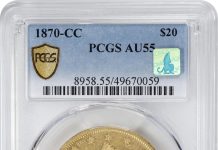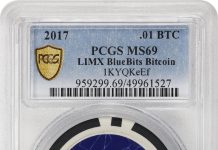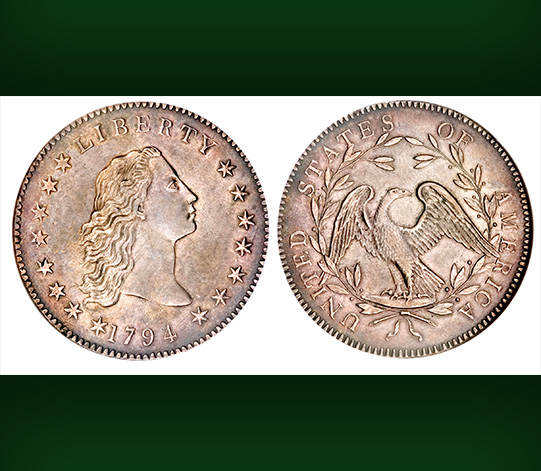
By R.W. Julian
When the first settlers from Britain came to what is now the United States, there was little in the way of coined money to use in the marketplace. Barter was the order of the day, and crops, such as tobacco in Virginia, were often used to pay taxes.
By 1652, this lack of a circulating coinage had become serious enough that Massachusetts began minting its own silver coins, suitably debased from the legal English standard. This reduced weight kept the silver at home and provided a measure of relief for hard-pressed merchants. In 1684, however, the coinage was halted when the London government refused to tolerate it any longer.
During the early 1700s, a continuing shortage of gold and silver forced Colonial governments to issue paper money in ever-increasing amounts, which soon depreciated when measured against specie. Parliament repeatedly passed laws forbidding such issues but made little effort to provide Colonial marketplaces with sufficient coinage.
One of the underlying causes of the American Revolution was the second-class status of the American economy. Political leaders, such as Benjamin Franklin, wanted the colonists to manage their own affairs, including the monetary system, without interference from the British Crown.
Currency to Fund the War
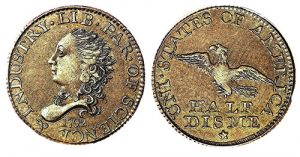
It took money to fund the Revolutionary War, and the colonists had little of that. So like the alchemists of old, they created a paper currency backed by the Spanish milled dollar. But it would have been a rare citizen indeed who could have persuaded the government to honor that pledge.
The Continental Congress was not as naïve as it appears, however. It had little or no taxing power and the issues of paper depreciated, creating a reverse tax. In effect, those who were forced to use the Continental currency thus paid for the war as the value of the bills continued to fall.
When the war was over, the public had seen enough of paper currency and a nearly bankrupt national government was barely able to remain in existence. In the 1780s more than one attempt was made to create a monetary system, but all failed because the government could not even find enough money to build a mint.
In 1787, influential citizens met in Philadelphia to hammer out a document later to be known as the Constitution. Written into this document were restrictions on the States issuing paper money though, despite popular belief to the contrary, the Federal Government had the power to do so.
Hamilton’s Recommendation Shapes Monetary System
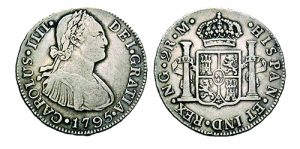
The new government began operations in April 1789 under President George Washington, and it was not long before Treasury Secretary Alexander Hamilton was able to bring order out of chaos when it came to finding the necessary funds to administer the country.
By late 1789, enough had been accomplished by Hamilton that the government turned its thoughts to a monetary system. In March 1790, Congress asked Hamilton to determine what was necessary to create our own coinage. His detailed report was submitted to the legislators in January 1791.
Hamilton recommended a bimetallic monetary system with a fixed relationship between gold and silver. He reported that the current international ratio was 15 to 1 (i.e. one ounce of gold was worth 15 ounces of silver) and suggested that we adopt this as our standard.
Some historians, in hindsight, have stated that Hamilton should have chosen a single standard, such as silver, because the gold and silver ratio on international markets tended to change over time. Hamilton, however, was only doing what was generally accepted in the 18th century, and the later failures of Congress to adjust the ratio in a timely fashion was not his fault.
Inspired by Spanish Milled Dollar
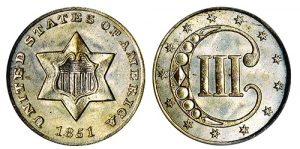
Hamilton chose the Spanish milled dollar (8 reales) as the basis for the new American dollar, giving it a content of 371.25 grains (24.06 grams) of pure silver. The weights of the gold coins were then calculated by Hamilton based on the suggested ratio of 15 to 1. He suggested that the fineness be 11/12ths (.917), meaning 11 parts of silver and one of copper.
At first, Congress did little except for a March 1791 resolution authorizing the President to carry out Hamilton’s ideas. By October, Washington had decided that the resolution was insufficient and informed Congressional leaders that something more concrete was required. The Senate got the point, and a committee was appointed to write draft legislation.
The Senate committee ignored Hamilton’s fineness and weight suggestions. The silver dollar, with the fractional pieces in tandem, now weighed 416 grains rather than the 405 grains recommended by Hamilton. The fineness was an awkward .8924. The amount of pure silver in the dollar, however, remained at 371.25 grains.
President Washington signed the coinage bill in early April 1792, and the rest of that year was spent preparing for coinage. In July 1792, a trial mintage of half dismes was undertaken under the authority of the President, but the issue was too small to be of importance.
In the 19th century, there was speculation that Martha Washington’s portrait had appeared on the 1792 half disme, but this theory later fell out of favor. Recent research, however, has shown that artist Joseph Ceracchi, who created the designs for the half disme, was a strong admirer of the First Lady and may well have used her portrait for this coin.
15 to 1 Ratio
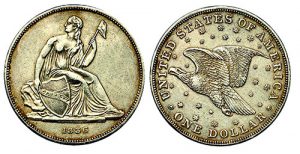
Because of high bond requirements for key Mint officers, regular coinage of the precious metals did not begin until October 1794, when 1,758 silver dollars were struck. Gold did not follow until July 1795. For a few years, the bimetallic system of gold and silver at the 15 to 1 ratio worked reasonably well. Little of the new coinage went into circulation, however, except for silver dollars and half dollars. Other coins, primarily gold, were exported or kept in bank vaults as backing for paper money.
It should be noted that the early silver coinage, prior to 1835, depended on private citizens bringing their silver bullion or foreign coins to the mints. (There was no government bullion fund for coinage until that year.)
Hamilton’s 15 to 1 ratio was a virtual dead letter by 1800. The international banking community, reacting to the ongoing military threats by Napoleon Bonaparte, grew nervous, and gold became more popular, and thus more valuable, as Europeans sought to find something that could be easily hidden yet maintain its intrinsic value.
With Congress loathe to act, Mint Director Elias Boudinot halted the coinage of silver dollars and gold eagles in order to keep our coins from being so heavily exported. The dollars in particular went to China, never to return. The outflow of silver did lessen but the loss of gold became worse, and by 1815 United States gold coins did not circulate in this country.
The loss of gold to the marketplace meant that silver was now the standard of value in the United States. We were now on a de facto silver standard and would remain so until 1834.
Diversifying the Monetary System
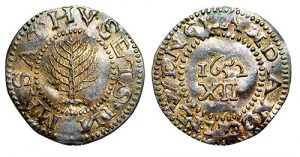
The Mint concentrated after 1805 on half dollars and half eagles, the latter being increasingly exported. The half dollars, on the other hand, were used in everyday transactions as well as backing for private issues of paper money by many banks. Half dollars even reached the frontier as they were used in Indian treaty payments.
Does this mean that the average person had no coins except the copper cent or half dollar for the marketplace? The answer is no because large quantities of small Spanish silver coins, such as the real (equal to 12.5 cents) and 2 reales (equal to 25 cents), were in widespread use. It is for this reason that store prices were often seen as 12.5 or 37.5 cents. Small U.S. silver coins were seldom seen until the late 1820s.
As a result of pressure from President Andrew Jackson, Congress in 1834 passed a law that changed the amount of gold in the coinage. Instead of a ratio of 15 to 1, the new arrangement was 16.002 to 1, more in line with the international marketplace. The result was that gold now came to the United States, rather than leaving our shores.
For the first time in U.S. history, there was now gold in everyday domestic use. By 1836, however, it was realized that the 1834 law had slightly overvalued gold, and the ratio was revised accordingly in January 1837 to 15.998 to 1. One of the reasons for this change was the concern that the new gold coinage might create a situation where silver would again be exported.
The 1837 law also changed the silver coins slightly by altering the fineness to .900. The pure silver content remained the same; however, the dollar weighed 412.5 grains instead of 416. The smaller silver coins were in proportion.
Impact of Bimetallism
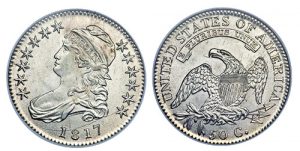
From 1837 through 1848, the nation enjoyed true bimetallism. In 1836 the Mint reintroduced the silver dollar to active use, although it was intended to be used by banks as reserves for their paper money. The idea was to reduce the number of half dollars struck by the Mint and thereby free up the coining presses for other denominations.
Bimetallism suffered a fatal blow with the 1848 discovery of gold in California. So much gold was mined that, coupled with equally large quantities from Australian mines, silver coins were soon undervalued. Bullion dealers began to buy up silver coins with gold, and by 1850 few silver coins were to be found in daily use.
In response to the coin shortage, Congress decreed in early 1851 a silver 3-cent piece, the trime, as a stopgap measure. It was sufficiently debased so that bullion dealers were not interested; it did not solve the coin shortage but was a strong step in the right direction.
The trime weighed only .8 of a gram, the lightest coin ever struck by the United States. The fineness was only .750, well below the .900 of the regular silver coins.
Congress took decisive action in February 1853 by lowering the weights of silver coins, except the dollar, by about 6 percent. The legal ratio of 15.998 to 1 remained in force, as depositors could still bring silver to the mints for dollar coins; otherwise minor silver coins were struck on government account only. The nation was now on a de facto gold standard because silver dollars no longer circulated. Arrows were placed at the dates of minor silver coins from 1853 to 1855 to denote the decrease in weight.
From 1837 to 1853, the half dollar, with the smaller silver in proportion, weighed 206.25 grains (13.36 grams), but this became 192 grains (12.44 grams) in 1853. The fineness did not change, and the trime was now struck to the same level of purity.
Conflict Forces Currency Change
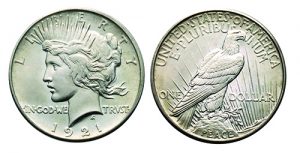
The 1853 reform put the monetary system back on an even keel. There was plenty of gold and silver for public use until 1861, when the Civil War erupted. The conflict forced yet another change in the currency. The year 1862 saw the complete disappearance of silver and gold coinage from the marketplace and replacement with paper money. The government had again turned to the printing press, just as in 1776.
In reality, some silver coins did continue to circulate, but only on the West Coast and in limited numbers.
The extraordinary cost of the war made it impossible for several years to bring gold or silver back into the marketplace. In early 1873, however, the mint laws were overhauled and the polite fiction about bimetallism still being in effect was quietly dropped. We were now officially on the single gold standard but without any gold coins in daily use.
By the summer of 1873, minor silver coins (with arrows again at the date, reflecting a slight increase in weight) found their way to the marketplace. The nation had once more weathered a severe monetary crisis and silver coins were in plentiful supply. The half dollar, for example, now weighed 12.5 grams instead of 12.44. Ostensibly, the change was to accommodate the metric system, but the real reason was to use more silver.
One of the denominations abolished by Congress in 1873 was the silver dollar, which was replaced by the Trade dollar, intended to export excess silver to the Orient. However, the ever-falling price of silver meant that those persons with a stake in the mining industry began to call for a resumption of regular dollar coinage. The idea was to allow the public to bring silver to the mints, but supporters failed to realize that this would have brought chaos to the monetary system.
Competing Markets
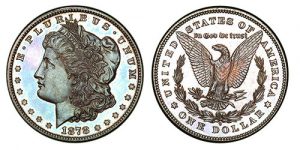
The Trade dollar weighed 420 grains (27.22 grams), 7.5 grains heavier than the old silver dollar. The increased weight was necessary to compete with the Mexican dollar in the Oriental market.
In February 1878, Congress responded by reinstating the silver dollar. However, mindful of the evils that would have resulted from unlimited coinage, the government was instead required to buy silver on the open market for the dollar coinage. The weight of the dollar remained at 412.5 grains and .900 fine silver, as adopted in the 1837 law.
Despite massive quantities of silver turned into dollars that nobody really wanted, in 1890 the Sherman Silver Purchase Act was passed, mandating even more silver to be purchased for dollar coinages. The result was disastrous.
Because the Sherman Act was perceived by European bankers as financial folly, foreigners holding American gold bonds began to demand payment in gold; soon the U.S. Treasury was facing bankruptcy. In 1893, newly inaugurated President Grover Cleveland, in an act of statesmanship, forced Congress to repeal the Sherman Act, thus saving the monetary system from collapse.
The 1896 presidential race between William Jennings Bryan and William McKinley ended in victory for the latter and also marked the effective end of the silver movement. Bryan, who knew next to nothing about monetary systems and market forces, made his famous “Cross of Gold” speech in which he blamed gold for most of the evils in the world. He demanded free coinage of silver at the old ratio of 16 to 1 at a time when the current market ratio was 30 to 1. The 1896 campaign was especially interesting for the tokens and medals that attacked or defended Bryan and his 16 to 1 proposal.
Formation of the Gold Standard
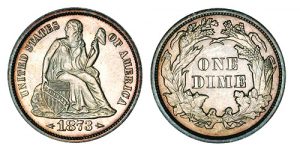
In 1900, as an afterthought, Congress passed a resolution stating that we were indeed on the gold standard while promising to use silver as much as possible in our coinage. Most legislators did not realize that we had been on the gold standard since 1853.
During World War I, large numbers of silver dollars were melted to aid the British war effort. Beginning in 1921, Peace dollars were struck to replace the melted Morgan dollars.
The depression that began in 1930 reached epic proportions in early 1933, forcing incoming President Franklin D. Roosevelt to take drastic steps. One of these measures, which proved a failure in the long run, was to take the United States off the gold standard and inflate the currency by raising the price of gold. Gold coinage was called in, and the right of the public to own gold was to remain in abeyance until 1974.
Although gold was no longer coined, silver was and in large quantities. The price of silver remained under $1 per ounce well into the late 1950s, but a growing demand for precious metals eventually forced an increase in price. By the early 1960s, United States mints were striking large numbers of silver coins at barely over melt value. A 1965 law put an end to silver coinage in the United States except for a debased half dollar containing 40% silver and weighing 11.5 grams.
The last of these debased half dollars was struck in 1970, and after that silver was permanently gone from the everyday coinage seen by the American public.
Silver coins had served the nation well until the 1960s but now are little more than a distant memory to the older generation of collectors.


